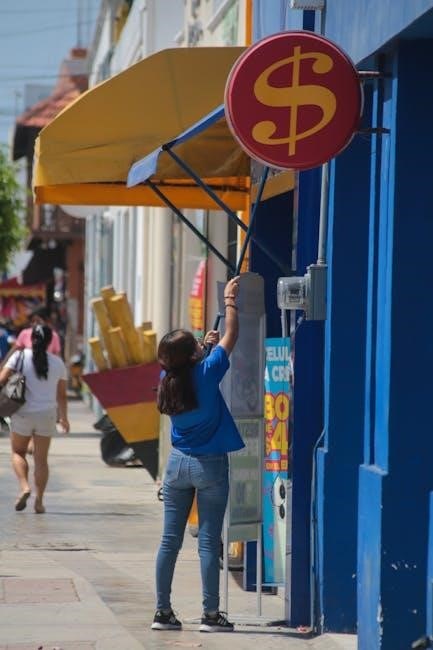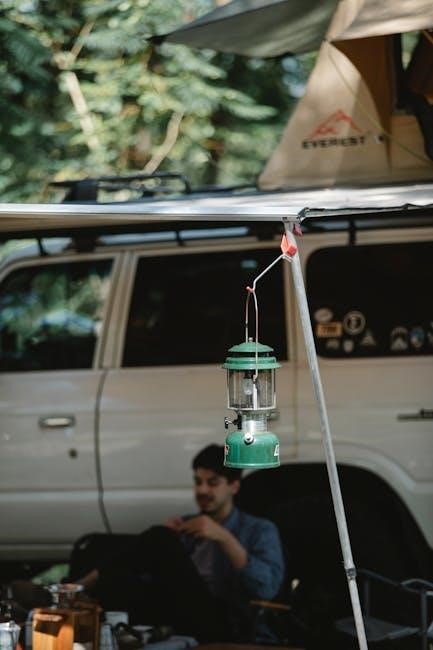Manually extending a Solara awning ensures reliable shade control, especially during power outages. This process, using a power drill and manual override nut, offers a straightforward solution for RV owners to maintain comfort and functionality. Always ensure safety and proper setup before extending to avoid damage or misalignment. Regular maintenance, like lubricating moving parts and cleaning fabric, keeps the awning in optimal condition. For campers, this feature enhances their outdoor experience by providing easy-to-use solutions, even without electricity. The Solara system’s design prioritizes user-friendly operation, making manual extension a practical choice for all RV enthusiasts. Proper techniques, as outlined, ensure smooth and safe awning extension every time.
1.1 Overview of the Solara Awning System
The Solara Awning System, designed by Lippert Components, is a versatile and reliable solution for RV owners, combining both electric and manual operation. Known for its user-friendly design, the system offers seamless integration of automatic and manual controls, ensuring functionality even during power outages. The Solara Awning features a durable construction, with high-quality materials designed to withstand various weather conditions. Its manual override mechanism is a standout feature, allowing users to extend or retract the awning using a power drill and a 7/16 socket. This system is ideal for campers and RV enthusiasts, providing shade and protection with minimal effort. Its innovative design ensures long-term durability and ease of use, making it a popular choice for outdoor enthusiasts. The Solara Awning System is engineered to enhance the camping experience while maintaining simplicity and reliability.
1.2 Importance of Manual Extension
Manual extension of the Solara Awning is crucial for maintaining functionality during power outages or motor failures. This feature ensures that users can still extend or retract the awning, providing shade and protection when needed. It also serves as a backup mechanism, preventing the awning from becoming inoperable. Manual operation allows for precise control, enabling users to adjust the awning to their desired position. Additionally, it enhances safety by preventing unexpected movements caused by power loss. The manual override mechanism is designed to be user-friendly, requiring only a power drill and a 7/16 socket. This ensures that even those less familiar with machinery can operate the awning with ease. The importance of manual extension lies in its reliability and convenience, making it an essential feature for RV owners and campers alike. Regular use of this feature also helps maintain the awning’s condition, ensuring it remains operational for years to come.
Understanding Solara Awning Components
The Solara Awning comprises essential components such as the motor, manual override mechanism, fabric, support arms, mounting hardware, and control switches. Understanding these parts is vital for proper operation and maintenance.
2.1 Key Parts of the Solara Awning
The Solara Awning features several key components designed for functionality and durability. The fabric provides shade and is securely attached to the roll tube. Support arms stabilize the awning, while the manual override mechanism allows for easy extension or retraction using a power drill. The mounting hardware ensures secure installation on the RV, and the control switches simplify operation. Additionally, the valance seam indicates proper extension, and the rafter arms provide structural support. These parts work together to ensure smooth operation and reliability, even during manual override processes. Understanding these components is essential for effective use and maintenance of the Solara Awning system.
2.2 Role of the Manual Override Mechanism
The manual override mechanism is a crucial feature of the Solara Awning, enabling users to extend or retract the awning without relying on electricity; This mechanism is essential during power outages or motor failures, ensuring continued functionality. By using a 7/16 socket and a cordless power drill, users can easily control the awning’s movement. Turning the override nut clockwise extends the awning, while counterclockwise retracts it. This feature provides peace of mind, allowing campers to adjust the awning as needed. The manual override ensures the Solara Awning remains operational in all conditions, making it a reliable choice for RV enthusiasts seeking consistent shade and protection. Its design emphasizes accessibility and ease of use, ensuring a seamless experience even when manual operation is required.
Preparation for Manual Extension
Ensure you have a cordless power drill and a 7/16 socket ready. Check the awning fabric is square on the roll tube and properly secured in the rail. Ensure all support arms are free and clear of obstructions for smooth operation. Verify proper alignment to avoid misalignment issues during extension. Always maintain a safe working area and follow safety guidelines to prevent accidents. Proper preparation ensures a seamless manual extension process. Keep the awning clean and lubricate moving parts regularly for optimal performance. This step is crucial for safe and effective manual operation of your Solara Awning.
3.1 Safety Precautions
Before manually extending your Solara Awning, ensure the area is clear of obstructions and people. Always wear protective gloves to prevent hand injuries. Avoid exposing the awning to high winds or heavy rain, as this can cause damage or structural stress. Never leave the awning unattended while extending or retracting. Ensure the awning is properly secured after extension to prevent accidental retraction. If the awning shows signs of damage, do not proceed with manual extension. Regularly inspect the fabric and hardware for wear and tear. Keep children and pets away during the process. Follow the manufacturer’s guidelines strictly to ensure safe and effective operation. Proper safety measures protect both you and your awning from potential harm.
3.2 Tools Required for Manual Operation
To manually extend your Solara Awning, you’ll need a few essential tools. A 7/16 socket and a cordless power drill are crucial for turning the manual override nut clockwise to extend or counterclockwise to retract the awning. Additionally, a set of screwdrivers may be necessary for securing or adjusting components. For fabric alignment, a soft-bristle brush can help clean debris from the awning rail. Ensure all tools are in good condition to avoid damaging the awning’s mechanisms. If your awning requires additional hardware, such as screws or brackets, have them ready before starting the process. Proper tools ensure a smooth and efficient manual extension process, minimizing the risk of damage or misalignment. Always refer to your awning’s manual for specific tool recommendations.

Step-by-Step Manual Extension Process
Engage the manual override nut with a 7/16 socket and cordless drill. Turn clockwise to extend the awning slowly, monitoring fabric alignment. Stop when fully extended and secure. Proper alignment ensures smooth operation and prevents damage. Always maintain control during extension to avoid sudden movements. Ensure the fabric is square on the roll tube for even extension. Use caution to avoid overextending, as this can strain the mechanism. Once extended, verify the awning’s stability and adjust as needed for optimal performance. This method ensures reliable manual operation, even without power. Regular practice improves efficiency and familiarity with the process. Follow these steps carefully for safe and effective awning extension. Proper technique is key to maintaining your Solara awning’s longevity and functionality. Always refer to the manufacturer’s guidelines for specific instructions tailored to your model. Avoid forcing the awning beyond its limit to prevent damage. By following these steps, you can extend your Solara awning manually with confidence and precision.
4.1 Initial Setup for Manual Extension
Before manually extending your Solara awning, ensure it is fully retracted and secure. Gather a 7/16 socket and cordless drill for the manual override nut. Check the fabric alignment to prevent misalignment during extension. Clear the surrounding area of obstacles to allow smooth operation. Ensure the RV is on level ground and apply brakes for stability. Loosen any locking knobs on the rafter arms to enable free movement. Verify the awning’s power switch is in the off position to avoid accidental motor activation. Inspect the manual override mechanism for proper engagement. Test the drill’s battery to ensure sufficient power for the process. Finally, ensure all users are aware of the manual extension procedure to maintain safety and coordination. Proper initial setup ensures a smooth and safe manual extension process.
4.2 Using the Manual Override Nut

To manually extend the Solara awning, locate the manual override nut on the awning’s mechanism. Attach a 7/16 socket to a cordless drill and securely fit it onto the nut. Spin the nut clockwise to extend the awning or counterclockwise to retract it. Apply steady, moderate pressure to avoid stripping the threads. Continue drilling until the awning reaches the desired position. Monitor the fabric’s alignment to ensure it rolls evenly. Be cautious not to over-extend, as this could damage the system. If resistance is felt, stop immediately and inspect for obstructions. Always maintain control of the awning during this process to prevent sudden movements. Proper use of the manual override ensures safe and effective operation of the Solara awning. Regular lubrication of the nut is recommended for smooth functionality.

4.3 Monitoring the Awning Fabric
While manually extending the Solara awning, it’s crucial to monitor the fabric for proper alignment and smooth rolling. Ensure the fabric remains taut and evenly distributed across the roller tube. Check for any signs of twisting or bunching, which can lead to misalignment. If the fabric appears uneven, stop the process and adjust it to prevent damage. Proper monitoring ensures the awning functions correctly and extends fully without obstruction. Always verify that the fabric is securely attached to the awning rail to maintain stability. Regular checks during extension help prevent issues like fabric wear or system malfunction. By keeping a close eye on the fabric, you can ensure a smooth and safe manual extension process every time.
4.4 Completing the Extension
Once the Solara awning fabric is fully extended, ensure it is securely locked in place. Verify that the valance seam is visible and the roll tube is slightly exposed, indicating complete extension. Tighten any necessary locking mechanisms to prevent movement. Check the fabric for squareness on the roller to ensure proper alignment. If using support arms, make sure they are properly engaged but not over-tightened, as this could restrict movement. Finally, test the awning by gently tugging on the fabric to ensure stability. Completing the extension correctly ensures the awning functions smoothly and remains secure in various weather conditions. Proper completion also prevents potential damage from improper alignment or loose connections.
Post-Extension Procedures
After fully extending the Solara awning, ensure it is securely locked and properly aligned. Adjust the position if necessary to achieve optimal shade and stability. Always check for fabric tightness and alignment to prevent damage. Avoid over-tightening support arms, as this may restrict movement. Regularly inspect the awning after extension to ensure all components are functioning correctly. Proper post-extension care ensures longevity and reliable performance of the Solara awning system.
5.1 Securing the Awning
After manually extending the Solara awning, ensure it is securely locked in place to prevent movement or damage. Use the provided locking mechanisms or support arms to stabilize the awning. Tighten the manual override nut firmly to hold the awning in its extended position. Check the fabric alignment and tension to ensure even distribution and prevent sagging. Avoid over-tightening, as this may strain the system. For added stability, especially in windy conditions, attach the support arms to the RV or ground anchors. Regularly inspect the awning’s securement points to ensure they remain tight and functional. Proper securing ensures the awning remains stable and provides reliable shade during use. Always follow the manufacturer’s guidelines for securing the awning to maintain optimal performance and longevity.
5.2 Adjusting the Awning Position
After extending the Solara awning, fine-tune its position for optimal shade and stability. Use the manual override nut to make incremental adjustments, ensuring the fabric is taut and evenly aligned. To adjust, insert a 7/16 socket into the override nut and rotate clockwise to extend further or counterclockwise to retract slightly. Check the awning’s alignment by inspecting the fabric’s tension and the roll tube’s visibility. Ensure the awning is level and properly angled to avoid sagging or uneven wear. For precise control, use short, incremental turns of the drill to avoid over-adjustment. Once satisfied with the position, secure the awning firmly to maintain stability. Always verify the awning’s alignment and tension before leaving it unattended, especially in windy conditions, to prevent damage or misalignment.
Common Issues and Solutions
Common issues include the awning not extending properly, fabric misalignment, or manual override mechanism problems. Solutions involve checking the override nut, realigning fabric, and consulting the manual for troubleshooting. Regular maintenance, such as lubricating parts and ensuring proper setup, helps prevent these issues and ensures smooth operation. Always address problems promptly to avoid further damage or malfunction.

6.1 Awning Not Extending Properly
If the awning fails to extend properly, check the manual override mechanism. Ensure the 7/16 socket is securely attached to the override nut. Turn the nut clockwise using a cordless drill to extend the awning. Monitor the fabric alignment and watch for the valance seam to appear, indicating full extension. Clear the surrounding area for safety and avoid obstructing the support arms. If issues persist, verify that the override nut is functioning correctly and that the fabric is not misaligned. Lubricating moving parts may resolve stiffness, ensuring smoother operation. Always refer to the manual for troubleshooting specific problems to prevent further damage or malfunction. Proper maintenance and regular checks can help avoid such issues in the future.
6.2 Fabric Misalignment
Fabric misalignment can occur during manual extension, causing uneven shading or potential damage. To correct this, ensure the valance seam is visible and the fabric is square on the roll tube. If misaligned, retract the awning slightly and adjust the fabric alignment before extending again. Check for obstructions or twists in the fabric that may cause uneven rolling. Secure the fabric in the awning rail properly to prevent further misalignment. Regularly cleaning and inspecting the fabric can help maintain proper alignment. If issues persist, consider consulting the manual or contacting a professional to ensure the awning operates smoothly and safely. Proper alignment is crucial for optimal performance and durability of the Solara awning system. Always monitor the fabric during extension to address any misalignment promptly.
6.3 Manual Override Mechanism Problems
Issues with the manual override mechanism can hinder the awning’s operation. Common problems include difficulty turning the override nut or stripped threads. To address this, ensure the nut is lubricated and free from debris. If the nut is stripped, replace it immediately to prevent further damage. Additionally, check for proper socket size (7/16″) and ensure the drill is set to the correct rotation direction. If the mechanism feels stiff, apply a silicone-based lubricant to moving parts. Regular maintenance, such as cleaning and lubricating, can prevent these issues. Always refer to the manufacturer’s guidelines for replacement parts and procedures. Addressing these problems promptly ensures smooth manual operation and extends the awning’s lifespan. Proper care of the manual override mechanism is essential for reliable performance.

Maintenance Tips
Regularly clean the awning fabric with mild soap and water to prevent dirt buildup. Lubricate moving parts annually to ensure smooth operation. Inspect all components for wear and tear, addressing issues promptly to maintain functionality. Store the awning properly when not in use to protect it from environmental damage. Following these maintenance tips extends the awning’s lifespan and ensures reliable performance. Proper care enhances durability and keeps the awning functioning optimally for years. Consistent upkeep is key to enjoying trouble-free shade and protection.
7.1 Cleaning the Awning Fabric
Cleaning the Solara awning fabric is essential for maintaining its appearance and functionality. Start by brushing away loose dirt or debris using a soft-bristled brush. Mix a solution of mild soap and lukewarm water, then gently scrub the fabric with a clean, non-abrasive sponge or cloth. Avoid using harsh chemicals, bleach, or power washers, as they may damage the material. Rinse thoroughly with clean water to remove soap residue. Allow the fabric to air dry completely before retracting the awning to prevent mildew. Regular cleaning prevents stains and extends the fabric’s lifespan. Inspect the fabric for any stubborn stains or discoloration and address them promptly. Proper cleaning ensures the awning remains durable and continues to provide reliable shade and protection. Consistent care is vital for maintaining its quality and performance over time.
7.2 Lubricating Moving Parts
Regular lubrication of the Solara awning’s moving parts is crucial for smooth operation and longevity. Inspect the hinges, springs, and manual override mechanism for signs of wear or friction. Use a silicone-based spray lubricant or penetrating oil to lubricate these components. Apply a small amount to pivot points and moving joints, ensuring coverage without over-saturating. Avoid using heavy oils or greases, as they may attract dirt and dust, leading to premature wear. Lubricate every 3-6 months or after exposure to harsh weather conditions. This maintenance step prevents corrosion, reduces friction, and ensures the awning extends and retracts effortlessly. Regular lubrication is essential for maintaining the awning’s performance and extending its lifespan. Always follow the manufacturer’s recommendations for suitable lubricants and application methods.

Storage and Retraction
Properly retract the Solara awning before storage to protect it from damage. Use the manual override or power drill to fully retract the fabric. Secure the awning tightly with straps or locks to prevent movement during travel or harsh weather. Regular retraction and storage maintain the awning’s condition and extend its lifespan. Always ensure the fabric is dry to avoid mold or mildew. Store the awning in a clean, dry environment when not in use for extended periods. Proper retraction and storage ensure optimal performance and durability of the Solara awning system.
8.1 Proper Retraction Techniques
To ensure the Solara awning is properly retracted, start by using the manual override mechanism. Attach a 7/16 socket to a cordless power drill and spin the manual override nut counterclockwise. This will begin the retraction process. As the awning retracts, monitor the fabric to ensure it winds evenly onto the roll tube. Proper alignment is crucial to prevent fabric misalignment. Once fully retracted, secure the awning with straps or locks to keep it in place during travel or storage. Always ensure the fabric is dry before retracting to avoid mold or mildew. For added security, especially in high winds or extended storage, consider using additional tie-downs. Proper retraction techniques protect the awning from damage and ensure smooth operation. Regular checks and maintenance are essential for long-term functionality.

8.2 Storing the Awning
Proper storage of the Solara awning is essential to maintain its condition and longevity. Always ensure the awning is completely dry before storing to prevent mold or mildew. Once retracted, secure the awning with straps or locks to keep it firmly in place. For added protection, consider using a high-quality cover or storage bag to shield it from dust and debris. Store the awning in a dry, secure location, ideally elevated to prevent pests from nesting underneath. Regularly inspect the fabric and hardware for any signs of damage before storing for extended periods. Proper storage techniques ensure the awning remains functional and ready for future use, safeguarding your investment and enhancing your outdoor experience.

Troubleshooting
Troubleshooting the Solara awning involves identifying common issues like the awning stopping mid-extension or fabric misalignment. Check the manual override mechanism for obstructions or damage. Ensure the fabric is properly aligned and not tangled. If the awning does not extend smoothly, verify that all locking knobs are disengaged and the manual override nut is functioning correctly. Addressing these issues promptly ensures optimal performance and prevents further damage. Regular inspections and timely repairs are key to maintaining the awning’s reliability and extending its lifespan. Always refer to the manufacturer’s guidelines for specific troubleshooting steps. Proper care ensures years of trouble-free use. Troubleshooting is essential for maintaining functionality.
9.1 Diagnosing Common Issues

Diagnosing common issues with the Solara awning begins with identifying symptoms like incomplete extension or uneven fabric alignment. Start by inspecting the manual override mechanism for obstructions or wear. Check if the awning stops mid-extension due to fabric tangles or misalignment. Ensure all locking knobs are fully disengaged, as they can prevent proper extension. Verify the manual override nut is turning smoothly and not stripped. If the fabric is misaligned, gently adjust it back into the rail without force. For motor issues, ensure power sources are functional. Regularly lubricating moving parts can prevent stiffness. Addressing these problems early prevents further damage and ensures reliable operation. Always refer to the troubleshooting guide for detailed steps; Proper diagnosis is key to effective awning maintenance. This process ensures your Solara awning functions optimally, providing shade and comfort without interruptions. Regular checks help maintain its performance and extend its lifespan. Troubleshooting common issues is essential for long-term reliability.
9.2 Repairing Damaged Components
Repairing damaged components of the Solara awning involves identifying and addressing specific issues promptly. If the manual override nut is stripped, replace it with a new one to ensure smooth operation. For fabric damage, inspect the material and repair or replace it as needed to prevent further tears. If the awning’s support arms are bent, straighten them carefully to maintain proper alignment. Lubricate any stiff moving parts to restore functionality. Ensure all screws and bolts are tightened securely. If the awning’s motor is faulty, consult a professional for replacement. Always retract the awning fully before performing repairs to avoid additional damage. Testing the awning after repairs is crucial to confirm proper operation. Regular maintenance can prevent major repairs and extend the awning’s lifespan; Addressing damaged components promptly ensures reliable performance and longevity; Proper repair techniques are essential for maintaining the awning’s integrity and functionality.